How to Fish Bridges for Bass | Bass Fishing Bridge Pilings
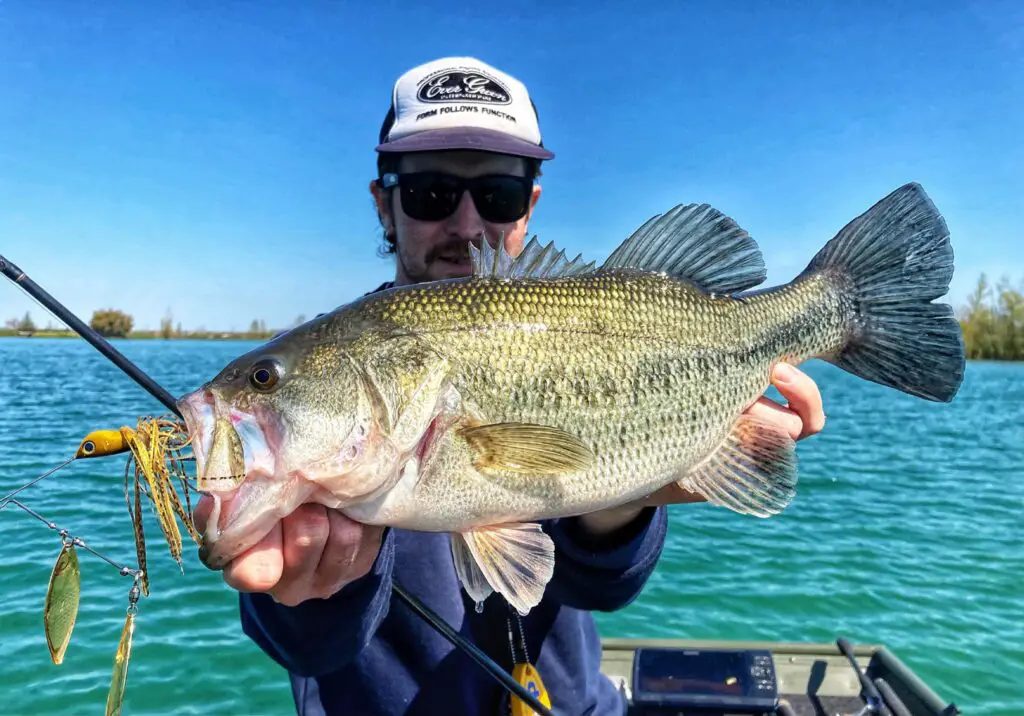
One thing is certain: not all bridges are made the same.
You may be asking yourself, how to fish bridges for bass? The key to bass fishing bridges are pretty simple: (1) looking for the areas on or around the bridge has a greater chance to hold fish; (2) knowing when is the best time to fish the bridge; and (3) understanding what baits work best.
Occasionally, if you visit any large lake you may see one or two bridges, but some lakes you’ll see tons… and… choosing where to start is overwhelming! And to make matters worse, most of the areas around the bridge may have the occasional fish near them, but the majority will have no fish at all.
To be blunt with you there are only two ways to become successful with fishing bridges.
The old way is to spend hundreds (if not thousands) of hours on the lake fishing every single part of the bridge – just hoping to catch a fish. But… for the majority of us we don’t have the time or the money to waste going that route, right?
The new way is to fish the bridges in a surgical systematic way that can instantly give you the confidence and green light to start fishing and catching bass fast!
Now take a second to think about this… Can you imagine yourself having the confidence to pull up to any bridge and instantly know if its a good bridge to be fished… or where is the best place on it that should be fished? Can you see how many more fish you can catch in one day just knowing that? Wouldn’t that be awesome?
Heck yes it would!
Listen, we both know that bridges are big structures… and if you’re like me and got suckered into fishing the wrong area without catching any fish… On top of that, it’s really frustrating wasting hours of your day, only to see other guys nearby jaw jacking huge bass!
In my fishing blueprint, I’m going to help you avoid all those frustrations… let’s get started…
Key Takeaways
Thankfully, bass fishing has become second nature to me now… but that wasn’t always the case. As I spent thousands of hours watching and learning from my mentors, practicing hundreds of hours on the lake… only to fail horribly…
However, over years of honing my skill whenever I had the chance, I slowly started to create my personal bridge fishing blueprint for beginners, which is kinda-like my private set of strategies and tactics. Now whenever I get to the lake and see a bridge, I use my same blueprint and I can quickly pick out the best locations that are most likely to hold fish… which allows me to avoid wasting hours of my fishing day… would you like to know more? Great, here are just some of the things in this blueprint you’ll learn how to fish bridges for bass:
- Understand what bridges and where on the bridge is more likely to hold fish… and… which to avoid as fast as humanly possible!
- How your PC can get you extra bites when you’re on the water!
- How you can legally check to see if the bridge piling attracts bass… even if the bridge piling looks like the hundreds of others in the area… you will get your answer in less than 1 minute… and helps you avoid spending countless hours on the wrong fishing spot!
- The single best way fish a bridge… this strategy gives you the right battle tested tactics that will not fail you… even if your brand new to bass fishing!
- Learn the best one-two punch for making bass bite when your bass fishing bridges – even Mike Tyson would be proud!
But be warned! Go through this blueprint slowly and carefully so you don’t miss any tips that could cost you.
Bridge Fishing Primer
Before we dive in deep with strategies and tactics I wanted to take the time to go over some basic reasons fishing bridges are awesome… now if you’ve been bass fishing for a while and are just here for some new tips just skip to the next section.
However, if you’re new to bass fishing where’s why…
We probably heard the term bridge fishing a lot, especially when fishing for bass. So, what does fishing a bridge, or bass fishing bridge pilings mean?
If your lake has any type of bridge it serves as a necessary factor for bass movement, provides them cover to feel safe, and lastly gives them a prime location to hunt for prey.
Helpful Tip: See a bridge? Think, bass magnets
Back to the subject matter, so why fish a bridge for bass? The answer is simple! Fishing bridges are “bass magnets” and are one of the easiest locations to catch bass.
This is because bass are not pelagic creatures; they migrate seasonally. Therefore, bridges and their surrounding structures are very advantageous to bass as they provide them with a multitude of benefits necessary for their survival.
Step 1: Understand the Different Areas of the Bridge
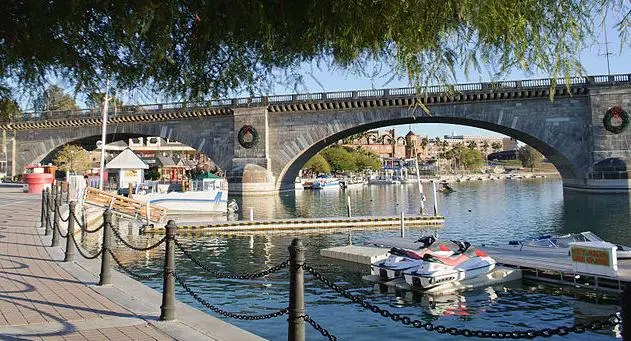
Straight riprap banks: This is a very popular part of the bridge for fishing bass. Due to this popularity, this area tends to be pressured. However, they are extremely productive all year round.
Riprap corners: This is where the straight banks run underneath the bridge and create a corner. These corners are highly populated with bass and are the most popular fishing spot on bridges.
The high population of bass in this area is because of bait fish which are often washed past these areas by wind and natural current. These bait fish can serve as meals to the bass, making riprap corners excellent feeding spots for the bass
Helpful Tip: Bridges are always going to be a pinch point they're going to be current... The river narrows down into a small open so there's always going to be more current.
B.A.S.S. Pro Andy Montgomery
Pilings: Bridge pilings are one of the most overlooked bass fishing spots. Although not as populated as the corners, it is important to not overlook this area. A common reason why anglers do not pay much attention to the pilings is because of the structure.
Pilings have gigantic concrete structures that most anglers feel would be intimidating to fish, which is correct for the most part. However, the bass favors this area over any other area in the water body sometimes and it is almost impossible to tell when this will happen.
For this reason, it is always best to explore this area as there is a possibility of catching a good piling bite.
Bridge gaps/holes: This is another commonly overlooked fishing spot in bridges. Many anglers tend to undermine the productiveness of bridge gaps. On the contrary, the gaps and holes of the bridges are an excellent spot to catch summer bass and late post-spawn.
Step 3: Fishing Bridges Systematically
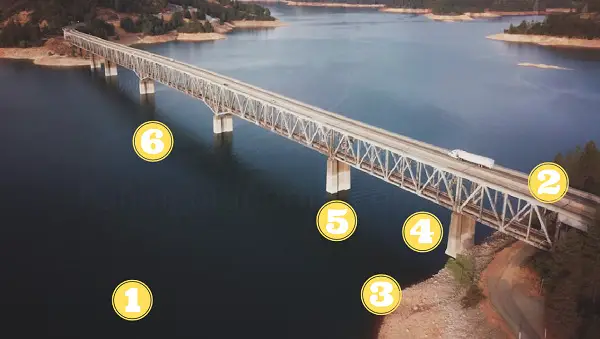
The ultimate technique when fishing a bridge for bass is going with the flow and you have to be willing to target nearly every part of the bridge in order to establish a pattern.
In my personal opinion, I like to approach and fish any bridge as if it were a dock-corners first, then the straightaway, then the individual pilings.
Here is a solid tournament winning strategy to fish any bridge you encounter:
Step 1: Determine the water clarity.
Bass like to place themselves shallow and become easier to catch in stained water, so it’s best to position your kayak or boat near to the rocks and concentrate on the 3 to 5-foot area.
On the other hand, if the water is clear bass love to frequently hold in deep water, or they can suspend in open water away from the riprap banks.
This can make them extremely hard to locate. In this instance, focus on the underwater area where the riprap finishes and a smoother bottom begins.
Step 2: Start with the riprap banks closest to land.
Beginning at the riprap banks that attach the bridge to dry land is going to be the easiest place to catch a bass.
Remember, that crawfish and little baitfish like shad, bluegill, perch, and gobies dwell, eat, and hide among the rocks in the riprap banks and rock piles that surround the bridge are a constant year round source of food for the bass.
Helpful Tip: Find out if your lake has water drawn out for electricity or agriculture. Often times you can download a time table of when they pull water out of the lake. This tell you when there will be current around the bridges.
Fishing the banks parallel is the easiest and quickest way to get bites. Fishing with fast moving lures such as a crankbait, spinnerbait, ChatterBait, underspin jig, swimbait, or an umbrella rig makes it even easier.
It is highly discouraged to fish this area with any slower moving lures unless there is something on the bank that is an abnormality on it, such as large boulder that is bigger than anything else around it, construction piling, rain culvert, piping, natural secondary point created by over-spill of rock placement during the construction of the bridge embankment.
Again, anything abnormal can be fished with a slower moving lure, otherwise fish this area relatively quickly.
Step 3: Then fish the point corners.
A corner of a riprap bank to a bridge acts like a point-on-a-point. There are several intersecting features to fishing a corner.
- It’s typically the structure that is closest to deeper water.
- Creates a funnel that nearly all forage has to pass around if they want to get to the other side.
When fishing bridge corners, the presence of current is crucial.
Any type of current will work, whether it’s caused by wind blowing over the corner, or by water movement (if the current is caused by a river system, of water being drawn for hydroelectricity production ,or if the current is caused by tidal forces).
The water flow will accomplish two crucial goals. It will force bass and baitfish to stack themselves in very confined, predetermined regions on the corner.
Depending on the clarity, they’ll be found shallow or deep.
As a rule of thumb: if it’s the morning or if it’s windy when casting closer to the bank is recommended.
However, if it is bright and sunny in the middle of the day then casting deeper is recommended.
He goes on to say, if you notice a riprap point, fish it first thing in the morning and when it’s breezy.
Step 4: Fish the pilings
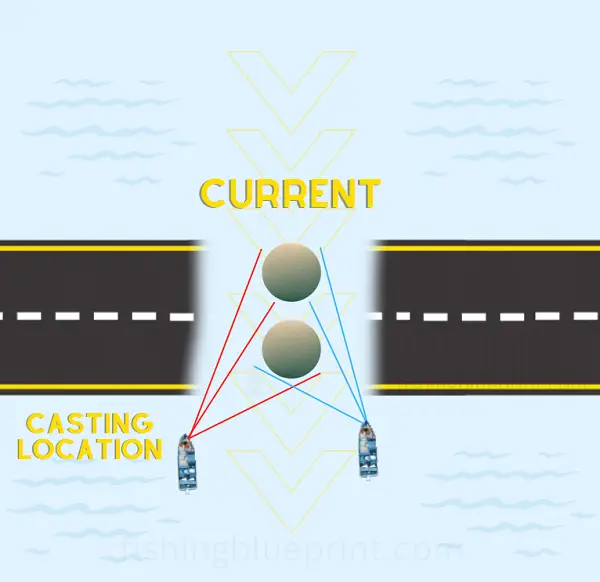
When someone tells you to fish the bridge pilings that can be incredibly confusing, especially if your bridge has 10+ pilings! So what are the best pilings to fish?
The bad news is all bridge pilings have the possibility to be solid fishing spots. The good news is there are pilings that offer a higher probability to hold fish. Here they are:
- Start with the pilings closest to the riprap bank closest to land.
- Then using your graph, identify the pilings that are closest to the deepest part of the main river channel
- Again using your graph, identify any secondary structure such as large rock piles or construction debris that are close to any additional pilings. These pilings should be fished third.
- Lastly, if a bridge piling doesn’t have any secondary structure close to it, or it’s not close to deep water. I personally wouldn’t spend much time on it.
In order to ambush baitfish, bass may treat a pronounced shadow line like a hard edge. The shadow line is just as important to the bass as pilings or stony banks.
Step 5: Fish the shadow line the bridge creates
It’s important to know that any distinct shadow lines that you can see on the water’s surface continue into deeper water. So by mid-morning, the sharp shadow line starts to corral and confine the bass to a small narrow area, which makes them more competitive and catchable.
Step 6: Fish the gaps between pilings
Fishing the gaps between the pilings is all about being in the right place and the right time. Often the situation is going to be on calm days with a slight breeze with little current.
Shad will start to school in the middle of the gaps to feed on the micro critters and bass follow.
You’ll often see bass busting the surface chasing shad any time throughout the day, so having a topwater lure or an umbrella rig tied on is key.
Step 7: Fishing suspended bass
A frustrating thing about fishing a bridge piling is if you observe the bass are suspending at a specific depth. The easiest way to address this is to use a lure that can dive to a specific depth such as Rapala DT crankbait, or a suspending jerkbait.
Many pros also become proficient in counting down the lure to the desired depth and slowly reeling back in, keeping it at that depth.
Drop-shot rigs can give the fish multiple looks. Start by threading on a small swimbait and make a long cast past a piling. By allowing the rig to pendulum through the water column on a semi-slack line it easily catches any suspended bass.
Changing the length of your cast will allow you to test a variety of depths as your bait travels along the pilings.
If you’re not getting any bites, you can quickly switch to a finesse drop shot worm, or ribbon tail worm to attract bigger bites.
Lastly, you can adjust the speed of the pendulum fall by increasing or decreasing the weight that’s attached.
Step 8 – Stay versatile and keep multiple baits handy
There are many places where bass may hide around bridges, so it’s necessary to try different methods and approaches as you fish bass.
Part of an angler’s versatility is searching the the areas on the bridge and testing them out to see if you can get a bite. Once you get a bite or two you can then start to develop a plan.
So stay versatile be having several baits in your boat or tackle bag that are ready to use if fishing circumstances change. You may start out with a shallow crankbait, but then may need to switch to a drop shot to fish a piling in 20 feet of water.
Helpful Tip: Don’t give the bass too much time to think about it. This shallow water lure may get a response from bass who do not want to be bothered, and they are hooked into before they realize what happened.
Remember that fishing bridges requires patience
Another basic that experienced anglers agree on is that the best strategy for fishing riprap is to be patient. Fishing riprap will require you to make a ton of casts and possibly work your way down the riprap bank… even if you think it’s the best bank.
Best Baits for Fishing Bridges
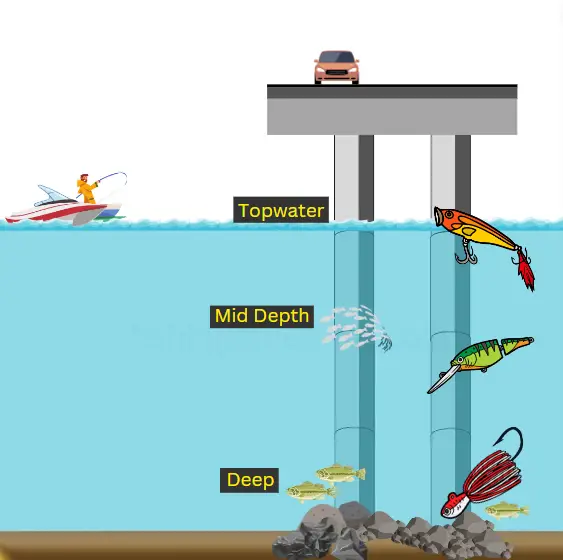
Andy Montgomery has taught me so much when it comes to fishing bridges and watching him in tournament footage.
1) Start with using a moving bait. Bass live on or around bridges all year long, especially in the summer. For this reason, moving baits would easily draw the attention of the bass and lure them easily towards you. Buzzbaits, walking baits, crankbaits, soft plastic swimbaits, spinnerbaits, Chatterbaits, jerkbaits, swim jigs, hair jigs, and underspin jigs when the bass are aggressive. Flutter spoons work great in the deeper channel sections as well.
2) Slow it down to pick off the more reluctant bass. If you’re not getting any bites from the fast moving baits it will be time to slow it down.
I really have the best success when I use a tungsten football jig. Here’s why…
Tungsten is a denser material than lead which means you get a heavier weight in a smaller package. Tungsten is nearly twice as hard than lead, and is about ½ the size of a lead jig,
The smaller sizes also means less drag… which also means it has a quicker fall rate for the same sized lead jig.
Lastly, since it’s more compact there is less chance for hangups.
My second or third choice for baits are going to be a Texas rig or Carolina rig with a compact soft plastic creature bait.
I’ll let the depth determine if I use a Texas rig or a Carolina rig.
- Deep areas in >12 feet of water, I’ll fish a Carolina rig.
- Shallow areas <12 feet I’ll go with a Texas rig.
And yes, I’ll thread on a tungsten bullet weight for the same reason that I outlined above.
Weedless drop shot rig and weedless wacky rig Senko are also great for bass fishing bridges without getting hung up or snagged.
6) And finally, be stealthy. During the process of checking the brush pile to see if there are bass around it and casting your bait, try to be as quiet as possible. You might not necessarily have to be quiet, but let the noise be steady. Do not rev your engines and maintain a steady rpm.
My Personal Notes: My 2 Biggest Problems with Fishing Bridges for Bass
When I was first getting started, I kept hearing “bridges hold the most bass” or “bridges are bass magnets”, but each time I set out to fish a bridge, I ended up with nothing. As expected this was very frustrating, but you need to know that even the most experienced anglers do not always end up with a bite. So if you’re currently facing some challenges, you’re probably not alone. Fishing bridges, although easy, can be very technical.
That is why I created my step by step way to fish each part of the bridge to start ruling out specific areas of the bridge.
Helpful Tip: Another thing I’ve learned throughout the years is you can jaw-jack bass with or without a fish finder. If you do not have a fish finder, use a topographic map of the lake to study the lake bottom.
Additionally, another thing I needed to keep in mind was I needed to be willing to change out my lures frequently, and change out the technique at a moment’s notice. Bass can be very fickle in the sense that they could be hitting a particular lure today and ignore it the next, or even from one piling to the next!
Changing the colors of my lure, the depth in which you’re casting, the position around the bridge you’re fishing or even the water body entirely is something you have to be willing to do. With bass fishing, change is constant.
That is why I developed my list of fast moving baits and slow moving baits to fish in all depths of water to start with and keep handy.
Take care and tight lines!
— George
Want To Learn Where To Catch More Bass? Checkout These Articles...
- Bass Fishing CREEKS The Easy Way (In Less Than 10 Minutes)
- Warning: Bass Fishing HEAVY GRASS? [15+ Mistakes To Avoid]
- Bass Fishing POINTS in 5 Quick & EASY Steps!
- Complete 5-Step DOCK Fishing Formula
- Bass Fishing LAYDOWNS [Complete Guide + Pictures]
- Little Known Pattern for Fishing TREES for Bass.. Now and Forever
- Complete Formula For BASS FISHING ROCKY BANKS & RIPRAP
- The 5 TRUTHS about Bass Fishing BRIDGES and Avoid Wasting Time On Techniques That Don’t Work!
- Bass Fishing BRUSH PILES To Catch The Most Bass In Minimum Time!
- The 7-step Secret Formula for Bass Fishing LEDGES – Even a Complete Fishing Noob Can Use and Be 100 Times More Potent Than the Best B.A.S.S. Professional!
- The Single Best Guide to Fishing SHELL BEDS… and… Do It Fast!
- 5 Basic Elements Of Fishing HUMPS AND RIDGES No One is Talking About!
- 5 Crucial (and Unusual) Tactics You Must Do When Bass Fishing ROADBEDS!
- Top 25 Summer BANK Fishing Tips (Never Get Skunked Again)
- [EXPERT REVEALS] Bass Fishing In MUDDY WATER Secrets – 27 Tips & Mistakes To Avoid Today!
- 31 Best Tips for Bass Fishing At NIGHT (Complete Guide)
Other Bass Fishing Articles Just For You...
Funny Fishing Rules, Laws, and Regulations 2025
Crazy Fishing Laws That Will Blow Your Mind! #7 is INSANE! Strange Fishing Regulations and Laws As silly as hook and rod limits may seem,
EXPOSED! How To Use A Spinnerbait The Right Way for 2025
Are You Wondering How To Use A Spinnerbait? Or How To Work A Spinnerbait Over Grass, Logs, or Points? Well, All These Questions Are Answered
EXPOSED! Best Crankbait Colors for 2025 [Which to Buy & Avoid]
What color crankbait to use? Crankbait Color Chart I just love going into a Bass Pro Shops store and just staring at all the walls
Best Underwater Dock Lights For Fishing – 2025 Buyers Guide
Night Dock Light Fishing For Beginners Dear fellow angler, Does this sound like you? You’re someone who loves fishing but just wants to escape the
15 Best Deep Diving Crankbaits [2025 Buyers Guide – Which to Buy & Avoid]
A Complete Buyer’s Blueprint On The Best Deep Diving Crankbaits for Bass, Walleye, or Striped Bass On The Market Today Fishing deep diving crankbaits can
